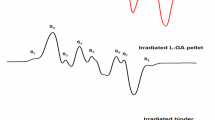Abstract
Windose B3 dosimeters have been investigated using UV–vis spectrophotometry to determine the impact of the frequent interruptions during gamma irradiation on the absorbed dose. To achieve this purpose, a set of experiments were conducted by examining the behavior of these dosimeters as result of these accidents. Experiments were conducted based on varying four influencing factors: the storage temperature, the number of fractions, the total delivered dose and the storage time. The chosen parameters (dose and fraction time) are selected from pre-studies and in accordance with conditions of industrial irradiation. The obtained results for one fraction or five fractions had bigger specific absorbance than the dosimeters receiving its dose without fractionation and that the effect of five fractions on the response of dosimeters is more significant than the effect of one fraction. The most important over response (15%) is obtained for 10 kGy as absorbed dose with five fractions, 40 °C as a storage temperature, and 24 h as storage time. The influence quantities have an effective effect on the Windose B3 dosimeter response and suitable corrections are indispensable.





Similar content being viewed by others
References
S. Biramonttri, N. Haneda, H. Tachibana and T. Kojima, Effect of low irradiation temperature on the gamma ray response of dyed and undyed PMMA dosimeters, Radiat. Phys. Chem., 48 (1996) 105–109.
A. Mejri, K. Farah, H. Eleuch and H. Ben Ouada, Application of commercial glass in gamma radiation processing, Radiat. Meas., 43 (2008) 1372–1376.
W.L. McLaughlin and M.F. Desrosiers, Dosimetry systems for radiation processing, Radiat. Phys. Chem., 46 (1995) 116–1174.
B. Whittaker and M.F.Watts, The influence of dose rate, ambient temperature and time on the radiation response of Harwell PMMA dosimeters, Radiat. Phys. Chem., 60 (2001) 101–110.
P. Sidereas, D.S.Garcia, R. Tracy and J.M. Holzman, Effects of elevated temperatures during interruption of irradiation on Harwell Red 4034 PMMA and Kodak biomax Alanine film dosimetry systems, Radiat. Phys. Chem.,76 (2007) 1826–1828.
K. Farah, F. Kuntz, O. Kadri and L. Ghedira, Investigation of the effect of some irradiation parameters on the response of various types of dosimeters to electron irradiation, Radiat. Phys. Chem.,71 (2004) 337–341.
W.L. McLaughlin., A.W. Boyed, K.C. Chadwich, J.C. Mcdonald and A. Miller, Dosimetry for radiation processing, Taylor and Francis Ltd., London, (1989).
N.K. Aggarwal and P.C. Jain, Uncertainties in slip gauge calibration, MAPAN-J. Metrol. Soc. India, 5 (1990) 27–31.
S. Basak and Dipali Kundu, Evaluation of measurement uncertainty in determination of lead in glass materials by a standard complexometric method, MAPAN-J. Metrol. Soc. India, 3 (2012) 175–182.
B.L. Gupta, U.R. Kini and R.M. Bhat, Dose-rate and fractionation studies with FBX dosimeter, Int. J. Appl. Radiat. Isot., 32 (1981) 701–704.
A. Mejri, K. Farah and F. Hosni, An empirical model for predicting Harwell dose variation during gamma process interruption using experimental design, MAPAN-J. Metrol. Soc. India, 30 (2015) 85–90.
W. Budde, Optical radiation measurements, physical detectors of optical radiation, Academic Press, New York, (1983). MAPAN-J. Metrol. Soc. India, 19(1–2) (2004) 19–22.
M. Sohrabpour, A.A. Kazemi, H. Mousavi and K.Solati, Temperature response of a number of plastic dosimeters for radiation processing, Radiat. Phys. Chem., 42 (1993) 783–787.
M.K. Murphy, A. Kovacs, S.D. Miller and W.L. McLaughlin, Dose response and post-irradiation characteristics of the Sunna 535-nm photo-fluorescent film dosimeter, Radiat. Phys. Chem., 68 (2003) 981–994.
http://gexcorporation.com, B3 radiochromic film dosimeters, product specifications by GEX company the dosimetry company, the accessed date 15/07/2015.
F. Kuntz, R. Fung and A. Strasser, A dedicated tool for then quality assurance in the field of radiation processing, Proceeding of the 11th international meeting on radiation processing, Melbourne, Australia, 1999.
K. Farah, T. Jerbi, F. Kuntz and A. Kovacs, Dose measurements for characterization of a semi-industrial cobalt-60 gamma-irradiation facility, Radiat. Meas., 41 (2006) 201–208.
P.H.G. Sharpe and A. Miller, Guidelines for the calibration of routine dosimetry systems for use in radiation processing. Teddington, UK (NPL report CIRM 29), (1999).
ISO/ASTM, Practice for calibration of routine dosimetry systems for radiation processing, ISO/ASTM Standard 51261-2013, ASTM International, West Conshohocken, PA, (2013).
www.aerial-crt.com, Product documentation by Aerial company the dosimetry company, the accessed date 11/05/2015.
P.S. Rao, S.C. Misra and P. Gangadharan, A reference standard for protection level calibrations in photon energy range 30 keV to 2 MeV, MAPAN-J. Metrol. Soc. India, 4 (1989) 123–128.
R. Kaarls, Evolving needs for metrology in trade, industry and society, MAPAN-J. Metrol. Soc. India, 19(1–2) (2004) 5–10.
F. Hosni, K. Farah, A. Mejri, A. Khayat, R. Chtourou and A.H. Hamzaoui, A study of the fractionation dose on the radiation response of Harwell Red-Perspex PMMA dosimeter, Nucl. Instrum. Methods Phys. Res. B., 290 (2012) 69–71.
Author information
Authors and Affiliations
Corresponding author
Rights and permissions
About this article
Cite this article
Romdhana, H., Mejri, A., Ben Hatira, F. et al. A Study of the Fractionation Dose Effect on the Radiation Response of Windose B3 Dosimeter. MAPAN 32, 305–310 (2017). https://doi.org/10.1007/s12647-017-0226-4
Received:
Accepted:
Published:
Issue Date:
DOI: https://doi.org/10.1007/s12647-017-0226-4




